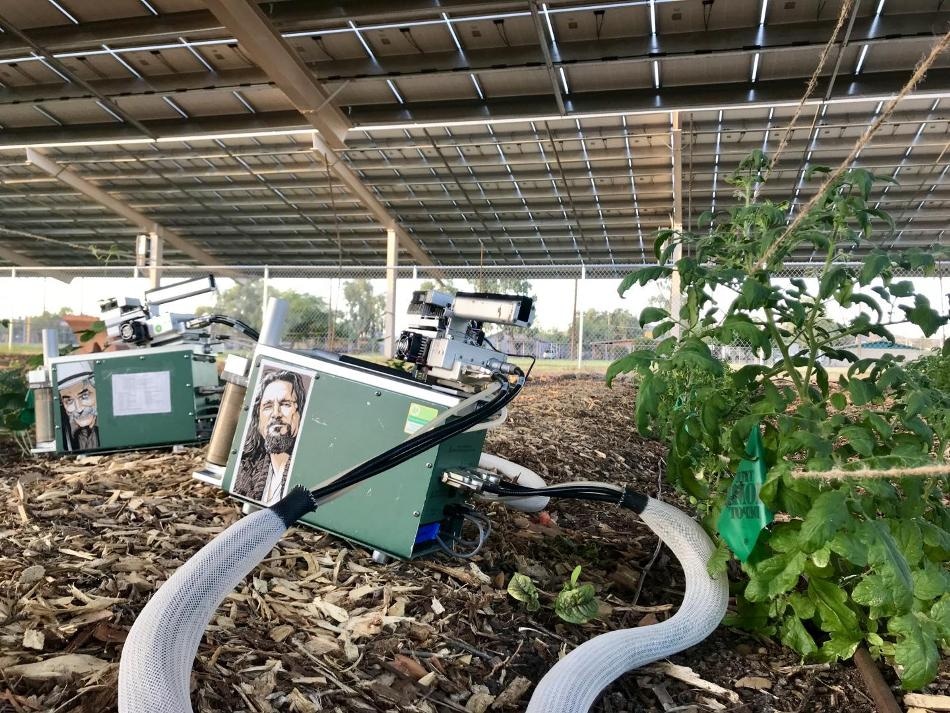Jul 30 2019
Farmers struggle to match production demands due to the progressively stressful climate. In other cases, producers of renewable energy struggle to deal with intense heat and weather. With rising temperatures, solar panels tend to become extremely hot to function well, and crops need more water, issues that are worsened by climate and drought conditions.
 The researchers test the heat and moisture under the solar panels to study the cooling relationship between the crops and panels. (Image credit: Greg Barron-Gafford)
The researchers test the heat and moisture under the solar panels to study the cooling relationship between the crops and panels. (Image credit: Greg Barron-Gafford)
Greg Barron-Gafford, associate professor at the University of Arizona, demonstrates that integrating these two systems—solar panel (photovoltaic) infrastructure and agriculture—can form a mutually advantageous relationship. This practice of co-locating the two by cultivating crops under the shade of solar panels is referred to as agrivoltaics.
In an agrivoltaic system, the environment under the panels is much cooler in the summer and stays warmer in the winters. This not only lessens rates of evaporation of irrigation waters in the summer, but it also means that plants don’t get as stressed out.
Greg Barron-Gafford, Associate Professor, University of Arizona
Crops growing under lower drought stress need less water, and because they do not wither as easily in midday heat, they are capable of photosynthesizing longer, and thus grow better.
In the southwestern US, there is plenty of sunlight, and the main means of setting up solar panels is to pack them densely into a site. Barron-Gafford’s research on the advantages of agrivoltaics does not alter that density, but just elevates the panels so the crops are growing in almost full shade.
What’s super interesting, is that we can cut back about 75% of the direct sunlight hitting the plants, but there is still so much diffuse light that makes it under the panels that the plants grow really well.
Greg Barron-Gafford, Associate Professor, University of Arizona
Barron-Gafford and his team collaborate with farmers via the university’s extension office, as well as with community farm colleagues in the Tucson region, in developing the test plots. The present agrivoltaic trials span about 165 m2, but larger installations on working farms are being planned in the coming year. They also partner with the Department of Energy’s National Renewable Energy Lab (NREL) to work towards consistency in forming plans of co-location installations.
The farmers help the scientists choose test crops as well. Every Spring and Fall, they cultivate tomatoes, beans, and a few types of peppers. They cultivate high-value herbs and spices, showing the potential for extra profits that can come from deliberately choosing crops that might not otherwise grow well in standard conditions, but that can presently grow well in the shade of solar panels.
They also include leafy greens such as chards, lettuces, and kale, which appear to grow well in this system. Plants in high-light surroundings are inclined to have smaller leaves—an adaptation for not absorbing excess sunlight and overwhelming the photosynthesis system. Plants in low-light surroundings grow larger leaves to pan out the light-capturing chlorophyll that allows plants to convert light to energy.
The scientists are noticing that in their trials, kale leaves are longer and wider, basil plants yield larger leaves, and chard leaves are larger. This is important for these crops as farmers harvest the leafy parts of these plants.
Co-location also benefits the solar panels themselves. In areas where it is more than 75 °F when sunny, solar panels start under-performing because they become very hot. The evaporation of water from the crops forms localized cooling, which decreases heat stress on the panels overhead and increases their performance. In brief, it is a win-win-win at the water-food-energy nexus.
When it is time to harvest the crops, it is really not a big trouble, explains Barron-Gafford, as farmers can use a lot of the same equipment.
We raised the panels so that they were about 3 meters (10 feet) off the ground on the low end so that typical tractors could access the site. This is was the first thing that farmers in the area said would have to be in place for them to consider any kind of adoption of an agrivoltaic system.
Greg Barron-Gafford, Associate Professor, University of Arizona
The main disadvantage of an agrivoltaic system is the cost of additional steel to elevate the panels, but Barron-Gafford believes increases in the production of food products and savings in water would counterbalance this additional investment. “I think the primary reason more producers aren’t using this system yet is lack of awareness or uncertainty about its potential,” he explains.
With proof of the advantages of this relationship between photovoltaics and agriculture, the team is aiming for even more efficient methods to co-locate. For example, they want to test solar panels that can be moved to totally vertical positions, allowing tractors to travel through the rows of panels to reach the soil and crops without having to raise the panels at all.
That said, Barron-Gafford explains that farmers do not need to pause for such future plans to accept this practice, and neither do solar enterprises. To gain from agrivoltaics at present, they do not have to do anything more than raise the masts that hold the rows of panels.
“That is part of what makes this current work so exciting,” he adds, “a small change in planning can yield a ton of great benefits!”
This talk, “Agrivoltaics in drylands: Co-location has food, water, and renewable energy benefits,” is part of a conference on biogeochemical consequences of renewable energy production.